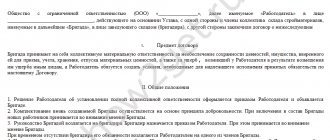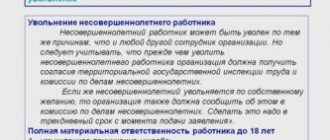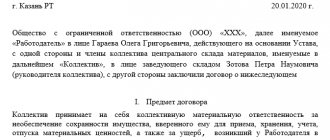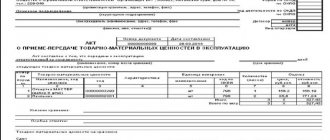Sample employment contract with financial responsibility
A sample agreement on individual financial responsibility of an employee can be found in Resolution of the Ministry of Labor of the Russian Federation dated December 31, 2002 N 85 (Appendix 2). It specifies the procedure for concluding and mandatory information blocks (the rights and obligations of the parties, the terms of the contract, the time of its entry into force; the form of the document is written, an oral agreement is not enough).
The material liability of the parties to the employment contract, which does not go beyond the scope of the Labor Code of the Russian Federation and does not require the execution of an agreement on full financial liability, is additionally required to be included in the text of this document.
If the position of the employee (s) or the work performed by him (them) is in the resolution of the Ministry of Labor of Russia “On the material responsibility of the employee” dated December 31, 2002 No. 85, the employer has the right (in the implementation of which he is primarily interested in himself) to register with such employee (their team) agreement on full financial responsibility.
For an employee to have full financial liability associated with his job functions, the conclusion of such an agreement in addition to the labor agreement is mandatory (Articles 244, 245 of the Labor Code of the Russian Federation). If this kind of liability is mentioned in the employment contract, but a separate document has not been drawn up for it, then the employee cannot be required to compensate for the damage in full.
Read about what is remarkable about the financial responsibility of a collective in the article “Agreement on collective financial responsibility - sample 2015.”
The exception is the deputy head of a legal entity and the chief accountant, whose full financial responsibility can be reflected in their employment contracts (Article 243 of the Labor Code of the Russian Federation). A separate document regarding this type of responsibility is not drawn up for them, since these positions are not listed in Resolution No. 85 (letter of the Federal Service for Labor and Employment dated October 19, 2006 No. 1746-6-1).
We suggest you read: What papers are needed to register a house?
You will find a version of the employment contract with the chief accountant, containing a condition on his full financial responsibility, on our website.
Agreement on full financial responsibility of the seller
The position of a salesperson implies that material assets are transferred to him in the process of work. Therefore, if the employer wants to be able to recover from him the full amount of the possible shortfall, he must necessarily sign a liability agreement with him.
Note! This document should spell out not only the seller’s obligations to pay the loss, but also the manager’s obligations to ensure proper safety of these valuables (equipping a warehouse or store with a security alarm, installing protection on windows, etc.).
You can sign agreements with sellers on both individual and collective financial responsibility.
https://youtu.be/4fSbnySDl_g
Material liability of the employee
An employee’s financial liability is divided into 2 main types: limited and full. The first does not imply its consolidation in any separate document and is limited to the amount of recovery - within 1 average monthly salary (Article 241 of the Labor Code of the Russian Federation).
The second, in turn, is divided into 2 subtypes (Article 243 of the Labor Code of the Russian Federation):
- Related to the official functions of the employee (workers), the nature of which allows the employer to draw up agreements with them on full financial responsibility - individual or collective. Such an agreement cannot be concluded with an employee under 18 years of age (Article 244 of the Labor Code of the Russian Federation). And such responsibility is assigned to the head of the organization by law, regardless of the fact of the conclusion of an additional document on responsibility with him (Article 277 of the Labor Code of the Russian Federation).
- Occurs in the presence of aggravating circumstances of the employee’s misconduct, such as intent, intoxication, criminal intent, disclosure of secrets, damage not related to the employee’s labor functions. Persons under 18 years of age may also be involved in it (Article 242 of the Labor Code of the Russian Federation). This responsibility arises by force of law and does not require prior documentation.
An employer can systematize all types of financial liability that it has in a special internal act.
Read more about this document in the article “Regulations on the material liability of employees - sample 2015”.
Damage can be compensated by the employee in the following ways (Article 248 of the Labor Code of the Russian Federation):
- By order issued by the employer no later than one month from the date the amount of damage was established, if its amount does not exceed the amount of the limitation.
- Voluntary in full. Then it can be paid off in installments by agreement with the employer. This fact is documented in a written agreement.
- Through the court. The employer can apply there no later than 1 year from the date of discovery of the damage (Article 392 of the Labor Code of the Russian Federation). This happens if the employee does not want to pay off the damage, the amount of which is greater than the established limit, voluntarily or if more than a month has passed since the date of determining the amount of damage.
In Art. 238 of the Labor Code of the Russian Federation states that employees bear obligations for the damage they cause. However, how much they must pay depends on what type of liability they have.
Article 238 of the Labor Code of the Russian Federation. Financial liability of the employee for damage caused to the employer
The employee is obliged to compensate the employer for direct actual damage caused to him. Lost income (lost profits) cannot be recovered from the employee.
Direct actual damage is understood as a real decrease in the employer’s available property or deterioration in the condition of said property (including property of third parties located at the employer, if the employer is responsible for the safety of this property), as well as the need for the employer to make costs or excessive payments for the acquisition, restoration of property or compensation for damage caused by the employee to third parties.
By degree of responsibility:
- Full (when damage caused to an enterprise will have to be answered to the fullest extent of the regulations; more obligations compared to limited MO).
- Limited (there are some types of incidents in which MO is not imposed on a specific person at this level of responsibility).
By number of persons:
- personal (for 1 person);
- collective (for a whole brigade, unit, unit).
By type of agreement:
- According to the employment contract.
- According to DMO.
- According to the contract for the transfer of mat. values.
Types of DMO
Reference! Mat. liability is the obligation of a member of the workforce to compensate the employer for damage (material) caused as a result of intentional, culpable failure to fulfill or poor performance of labor obligations.
It can be personal, collective, complete or limited. Accordingly, there are also different types of contracts.
We invite you to familiarize yourself with: Sample of filling out a lease agreement for non-residential premises
An agreement on full financial responsibility must be signed by the employee separately from the main employment contract. It is possible to sign them at different periods of time or on the same day - it does not matter.
Simply, the occurrence of this responsibility will begin from the moment the DMO is concluded. There is a current list of professions with representatives of which an employer can sign a DME. The list can be found by reading Resolution No. 85 of the Ministry of Labor of the Russian Federation.
Together with the DMO, the employee must sign a document confirming familiarization with departmental instructions, which indicate the procedure for storing and using the transferred property.
DMO allows you to demand that the employee reimburse the entire curse. the damage he caused. It also leaves virtually no chance for the perpetrator to escape responsibility.
Collective
It is concluded not only with one employee, but also with several subordinates. This opportunity for the employer is enshrined in Art. 245 Labor Code of the Russian Federation. This agreement is convenient if mate. values are used in work not by one person, but by a whole team.
Employees of this team can work in shifts or perform various functions related to servicing the same mats. values.
Note! In order not to carry out inventory every day or every week, a general agreement is signed. responsibility. About which a corresponding order is issued, with which all swearing must be familiarized. responsible employees.
Partial mat agreement. liability is most often not separately included. Because Each employee, according to his standard employment contract, is a mat. responsible person.
With whom can I enter into a contract?
According to the Resolution of the Ministry of Labor of 2002 No. 85, agreements on financial liability can be concluded with a limited list of employees.
The list of professions with which it is possible to conclude an agreement includes cashiers, accountants, salespeople, administrators, delivery drivers, storekeepers, etc. If we are talking about collective responsibility, then agreements are concluded with a team of sellers, a team of builders, forwarders, etc.
An agreement on material liability is concluded only in relation to adult workers whose job responsibilities are related to material and monetary values.
Rules for imposing financial liability on an employee
The employee is subject to a presumption of innocence - the employer must prove the fact of causing damage. Thus, he must prove that direct damage occurred as a result of illegal actions or inaction of the employee (he did not fulfill his duties, and because of this property was damaged), and identify the causal relationship between the employee’s actions and the damage caused.
The damage itself must be recorded in the inventory during the inspection, on the basis of which a report will then be drawn up. Its size is determined by the losses incurred. They are calculated taking into account market prices (currently in a given area) and the degree of depreciation of the property.
Who can be entrusted with full individual financial responsibility?
The Labor Code of the Russian Federation allows the employer to demand compensation from the employee for direct actual damage caused to him. It is stipulated that a subordinate may bear limited liability (within the limits of the average monthly salary) or full. Cases where an employee over 18 years of age will have to compensate for all company expenses are clearly stated in the law. These include:
- shortage of material or monetary property that was previously transferred to the employee according to documents;
- causing harm intentionally or while intoxicated;
- illegal actions of an employee, proven by a court or established by a government agency, which caused damage;
- causing damages during non-working hours for the perpetrator;
- allowing the disclosure of classified documents or information protected by law.
If the employee is a minor, then it is allowed to bring him to full financial liability under the circumstances specified in paragraph. 3 tbsp. 242 Labor Code of the Russian Federation.
How to draw up a standard contract{q}
The DMO is an official document that has a number of requirements. If they are not taken into account, the agreement will simply be considered void.
So, the mat agreement. responsibility must be in writing:
It is drawn up in two copies - one for the employer, one mat. responsible employee. Moreover, on the copy that is kept by the employer, it is advisable to put a mark indicating that the employee received his copy of the contract. Although this procedure is not mandatory, it is still better to follow it in order to avoid problems during the recovery of damages.
- It must indicate who transfers property to the employee and on what basis. In addition, the contract must indicate all the information about to whom the property is entrusted.
- It should also state that the employee does not object to being given a full swear word. responsibility for the transferred property.
- In addition, it is necessary to indicate the responsibilities of the enterprise: creating conditions that are mandatory for the safety of the mat. values.
- At the end, the document must be certified by the signatures of the head of the organization and the worker. We should not forget about the list of property that was transferred.
Therefore, the DMO must necessarily contain:
- information about the employee and the company;
- duties of the parties;
- list of transferred property;
- date and signatures.
We wrote about what an individual liability agreement is and how to conclude it here, and you can learn about drawing up an agreement on full liability here.
Types of liability
To one degree or another, the financial responsibility of the parties to an employment contract is always provided for; the very type of such regulation of relations between the employee and the employer will simply change. There can be 3 types in total:
Limited
A specific sample contract is not signed, but the Law stipulates that if damage is caused to the organization, the employee will have to compensate it. If the employer then wants to receive a larger amount, then he needs to go to court - he will not be able to demand anything on his own;
Full individual
Such agreements include a standard agreement on full individual liability. These usually include
the following documents:
- seller's liability agreement;
- agreement on material liability of the storekeeper;
- agreement on the driver’s financial responsibility for the car;
- agreement on the liability of an accountant.
But here the fact must be clearly stated that these values are easily subject to allocation, material assessment, and also that they were entrusted to the individually responsible person and no one has access to them without his consent;
Full collective
An agreement on collective liability differs primarily in that it is signed simultaneously with a group of persons who are responsible for
property of the organization. The amount of damages for each of these employees may also be clearly stated in the agreement. If this is not the case, then the persons must compensate for the damage in equal shares. Such agreements include: an agreement on full collective brigade financial responsibility or with a group of storekeepers, cashiers, sellers, etc.
An agreement with a cashier or a storekeeper is concluded depending on whether one person or several have access to valuables. If several cashiers work simultaneously in a store, then they will answer collectively.
The document on the financial responsibility of the storekeeper or forwarder is drawn up in exactly the same way. The manager in charge of the warehouse is most often still responsible for any losses.
But financial liability with the driver depends on whether he uses the car alone or is the owner; other employees also have access to the car.
In what cases does financial liability arise?
https://www.youtube.com/watch{q}v=ytcopyrightru
We invite you to read: What are the payments under the health insurance policy?
It arises only if the employee’s guilt is proven. Damage means deterioration (decrease) or complete loss of valuable property. If force majeure or self-defense occurred, the employee cannot be punished. Damage will not be recovered if there was a so-called production and economic risk (for example, new technical equipment was tested and some of them were damaged).
The employer is obliged to create conditions for normal work, ensure labor safety and preservation of employees’ property while they perform their duties. Financial liability arises if the property of employees is damaged, as well as if the employer violates the employee’s right to fulfill his duties: does not pay him wages on time, or somehow causes him moral suffering.
Design features
As we have already written, the DMO is drawn up between the employer and the employee (or team) to whom the checkmate is entrusted. values.
Therefore, this document is signed by these parties. It can be concluded upon hiring an employee. Or after carrying out the necessary audit procedures and concluding an act of acceptance and transfer of property. In any case, checkmate. responsibility begins from the moment of signing.
Important! The contract must be signed by both the employer and the employee. Otherwise, it has no legal force. And it will not be possible to recover damages for it.
Shelf life
According to Art. 257 Order of the Ministry of Culture of Russia dated August 25, 2010 N 558 “On approval of the “List of standard management archival documents generated in the process of activities of state bodies, local governments and organizations, indicating storage periods”, the enterprise must retain the document for 5 years from the date of expiration actions.
Those. five after the worker quit or ceased to be a financially responsible person. You can recover damages within a year after discovering a shortage or other property loss.
Most often, the HR department is responsible for drafting. But the chief accountant and lawyer only agree on it, what can be noted. Also, the employee who is responsible for drawing up contracts must also be responsible for their registration in a special journal, which we talked about in this material.
How to terminate a contract without dismissal
Termination of an agreement on full financial liability is possible for various reasons at any time, for example, when the employer decides to relieve the employee of the material burden for the safety and condition of valuables. An employee may be transferred to another position for which such a function is not provided (we will not hide, as an option, when transferred from the position of “cashier” to the position of “accountant” without performing the duties of a cashier).
In this case, the employer needs to take a number of actions, in particular, conduct an inventory. Based on its results, an act is drawn up. If there are no shortages when reconciling property and, accordingly, claims, a special agreement must be drawn up.
The steps of the process are as follows:
Step 1. Assign an inventory procedure.
Step 2. Determine the members of the commission, in which it is desirable to include a lawyer.
Step 3. Carry out the procedure for reconciling property.
Step 4. Based on the results of the reconciliation, record the immediate result and draw up an inventory sheet.
Step 5. Draw up and sign in 2 copies an agreement to terminate the contract for financial liability. Leave one with the employer, give the second to the employee.
Step 6. Carry out the actual in-person (not over the phone) transfer of property at the address where it is located (for example, if the organization is located in Moscow, it is there), drawing up a transfer and acceptance act based on the results of a preliminary inventory.
Step 7. Draw up an additional agreement to relieve liability of a material nature for the position held by the employee and do not forget to say “Thank you” to the employee for the duties performed.
The date of announcement of the end of the financial liability agreement specified in the agreement means that from that moment the employee is not responsible for the property that was previously entrusted to him.
How to recover damages
Damage may be recovered by the administration (no more than 20% will be deducted from the employee’s salary each month). It is important here that such an order was given no later than a month from the moment the amount of damage was established. Such a penalty is possible if the employee does not object to it.
You can also recover damages through court. This is usually resorted to if the administration did not manage to issue an order within a month (however, no more than a year has passed since the offense), the amount of payments is greater than the average monthly earnings of the employee, he himself expressed his disagreement with such actions (the very fact of the penalty or its size) or resigned From the job.









